Popular music is
music with wide appeal[1][2][3] that is typically distributed to large
audiences through the music industry. These forms and styles can be
enjoyed and performed by people with little or no musical training.[1]
It stands in contrast to both art music[4][5][6] and traditional or
"folk" music.[dubious – discuss] Art music was historically
disseminated through the performances of written music, although since
the beginning of the recording industry, it is also disseminated
through recordings. Traditional music forms such as early blues songs
or hymns were passed along orally, or to smaller, local
audiences.[4][5][6]
The original application of the term is to music of the 1880s Tin Pan
Alley period in the United States.[1] Although popular music sometimes
is known as "pop music", the two terms are not interchangeable.[7]
Popular music is a generic term for a wide variety of genres of music
that appeal to the tastes of a large segment of the population,[8]
whereas pop music usually refers to a specific musical genre within
popular music.[9] Popular music songs and pieces typically have easily
singable melodies. The song structure of popular music commonly
involves repetition of sections, with the verse and chorus or refrain
repeating throughout the song and the bridge providing a contrasting
and transitional section within a piece.[10] From the 1960s through the
mid-2000s, albums collecting songs were the dominant form for recording
and consuming English-language popular music, in a period known as the
album era.[11]
In the 2000s, with songs and pieces available as digital sound files,
it has become easier for music to spread from one country or region to
another. Some popular music forms have become global, while others have
a wide appeal within the culture of their origin.[12] Through the
mixture of musical genres, new popular music forms are created to
reflect the ideals of a global culture.[13] The examples of Africa,
Indonesia, and the Middle East show how Western pop music styles can
blend with local musical traditions to create new hybrid
styles.[clarification needed]
|
ポピュラー音楽とは、一般的に音楽業界を通じ
て多くの聴衆に広くアピールされる音楽のことだ。これらの形態やスタイルは、音楽的な訓練をほとんど、あるいはまったく受けていない人でも楽しんだり演奏
したりすることができる。ポピュラー音楽は、芸術音楽や伝統音楽、「民俗」音楽とは対照的である。芸術音楽は歴史的に、書かれた音楽を演奏することによっ
て広まってきたが、レコーディング産業が始まってからは、録音によっても広まっている。初期のブルース・ソングや賛美歌のような伝統音楽は、口頭で、ある
いは小規模な地元の聴衆に伝えられた。
ポピュラー音楽は、1880年代のアメリカのティン・パン・アレー時代の音楽を指す。ポピュラー音楽は「ポップ・ミュージック」と呼ばれることもあるが、
この2つの用語は互換性がない。ポピュラー・ミュージックは、多くの人々の嗜好に訴える多種多様なジャンルの音楽の総称であり、ポップ・ミュージックは通
常、ポピュラー・ミュージックの中の特定の音楽ジャンルを指す。ポピュラー音楽の歌や曲は、一般的に歌いやすいメロディーを持つ。ポピュラー音楽の曲の構
成は、詩とコーラスまたはリフレインが曲全体を通して繰り返され、ブリッジが曲の中で対照的で移行する部分を提供する、セクションの繰り返しが一般的であ
る。1960年代から2000年代半ばまで、英語圏のポピュラー音楽を録音・消費する場合、アルバムに収録された楽曲が主流であった。。
2000年代には、楽曲や小品がデジタル・サウンド・ファイルとして入手できるようになり、音楽が国や地域から別の国や地域に広まることが容易になった。
ポピュラー音楽の中には、世界的な広がりを見せるものもあれば、発祥の地の文化圏で広く親しまれるものもある。アフリカ、インドネシア、中東の例は、西洋
のポップミュージック・スタイルが、いかに地元の音楽伝統と融合して新しいハイブリッド・スタイルを生み出すかを示している[要出典]。
|
Definition
Further information: Folk music
Folk music is a genre of music that can be classified as more rural or
traditional music. Folk music is similar to oral stories as it can be
passed down through generations of families and cultures.
See also: Art music § Popular music
Some sort of popular music has existed for as long as there has been an
urban middle class to consume it. What distinguishes it above all is
the aesthetic level it is aimed at. The cultural elite has always
endowed music with an exalted if not self-important religious or
aesthetic status, while for the rural folk, it has been practical and
unselfconscious, an accompaniment to fieldwork or to the festivals that
provide periodic escape from toil. But since Rome and Alexandria,
professional entertainers have diverted and edified city dwellers with
songs, marches, and dances, whose pretensions fell somewhere in
between."
— Robert Christgau, in Collier's Encyclopedia (1984)[14]
Scholars have classified music as "popular" based on various factors,
including whether a song or piece becomes known to listeners mainly
from hearing the music (in contrast with classical music, in which many
musicians learn pieces from sheet music); its appeal to diverse
listeners, its treatment as a marketplace commodity in a capitalist
context, and other factors.[6] Sales of 'recordings' or sheet music are
one measure. Middleton and Manuel note that this definition has
problems because multiple listens or plays of the same song or piece
are not counted.[2] Evaluating appeal based on size of audience (mass
appeal) or whether audience is of a certain social class is another way
to define popular music, but this, too, has problems in that social
categories of people cannot be applied accurately to musical styles.
Manuel states that one criticism of popular music is that it is
produced by large media conglomerates and passively consumed by the
public, who merely buy or reject what music is being produced. He
claims that the listeners in the scenario would not have been able to
make the choice of their favorite music, which negates the previous
conception of popular music.[15] Moreover, "understandings of popular
music have changed with time".[2] Middleton argues that if research
were to be done on the field of popular music, there would be a level
of stability within societies to characterize historical periods,
distribution of music, and the patterns of influence and continuity
within the popular styles of music.[16]
Anahid Kassabian separated popular music into four categories:
"popular as populist," or having overtones of liberation and expression; see jazz, Latin music, and rhythm and blues.[17]
"popular as folk," or stating that the music is written by the people,
for the people; see country music, reggae, and gospel music.[18][19]
"popular as counterculture," or empowering citizens to act against the
oppression they face; see punk rock, heavy metal music, and hip hop
music.[20]
"popular as mass," or the music becomes the tool for oppression.[21]
A society's popular music reflects the ideals that are prevalent at the
time it is performed or published.[22] David Riesman states that the
youth audiences of popular music fit into either a majority group or a
subculture. The majority group listens to the commercially produced
styles while the subcultures find a minority style to transmit their
own values.[16] This allows youth to choose what music they identify
with, which gives them power as consumers to control the market of
popular music.[16]
Music critic Robert Christgau coined the term "semipopular music" in
1970, to describe records that seemed accessible for popular
consumption but proved unsuccessful commercially. "I recognized that
something else was going on—the distribution system appeared to be
faltering, FM and all", he later wrote in Christgau's Record Guide:
Rock Albums of the Seventies (1981), citing that records like The
Velvet Underground and The Gilded Palace of Sin (by Flying Burrito
Brothers) possessed populist qualities yet failed to impact the record
charts. "Just as semiclassical music is a systematic dilution of
highbrow preferences, semipopular music is a cross-bred concentration
of fashionable modes."[23] In his mind, a liking "for the nasty,
brutish, and short intensifies a common semipopular tendency in which
lyrical and conceptual sophistication are applauded while musical
sophistication—jazz chops or classical design or avant-garde
innovation—is left to the specialists."[24]
American folk singer Pete Seeger defined pop music as "professional
music which draws upon both folk music and fine arts music".[25]
|
定義
さらに詳しい情報 フォークミュージック
フォーク・ミュージックは、地方音楽または伝統音楽に分類される音楽のジャンルである。フォーク・ミュージックは、家族や文化の中で何世代にもわたって受け継がれるため、口承物語に似ている。
以下も参照のこと: 芸術音楽§ポピュラー音楽
ある種のポピュラー音楽は、それを消費する都市部の中産階級が存在する限り存在してきた。ポピュラー音楽の特徴は、その美的レベルにある。文化エリートは
常に、音楽に対して、宗教的あるいは美学的な地位とまではいかなくても、高尚な地位を与えてきた。一方、農村の民衆にとっては、音楽は実用的で無自覚なも
のであり、畑仕事のお供であったり、労働からの定期的な逃避を提供する祭りのお供であったりした。しかし、ローマやアレキサンドリア以来、プロのエンター
テイナーたちは、歌や行進曲や踊りで都市生活者の気をそらし、教養を高めてきた。
- ロバート・クリストガウ、『コリアーズ百科事典』(1984年)所収[14]。
学者たちは、(多くの音楽家が楽譜から楽曲を学ぶクラシック音楽とは対照的に)楽曲や曲が主に音楽を聴くことによってリスナーに知られるようになるかどう
か、多様なリスナーにアピールするかどうか、資本主義的文脈における市場商品としての扱い、その他の要因など、様々な要因に基づいて音楽を「ポピュラー」
に分類している[6]。ミドルトンとマニュエルは、この定義には、同じ曲や楽曲の複数回の試聴や再生がカウントされないという問題があると指摘している
[2]。聴衆の規模(マス・アピール)や、聴衆が特定の社会階級に属するかどうかに基づいて魅力を評価することも、ポピュラー音楽を定義する方法の一つで
あるが、これも、人々の社会的カテゴリーを音楽スタイルに正確に当てはめることができないという問題がある。マニュエルは、ポピュラー音楽に対する批判の
一つは、ポピュラー音楽が大規模なメディア複合体によって生産され、大衆によって受動的に消費されることであり、大衆は生産された音楽を買うか拒否するか
するだけである、と述べている。彼は、シナリオに登場するリスナーは自分の好きな音楽を選択することができなかったはずであり、ポピュラー音楽に対するこ
れまでの概念を否定するものだと主張している[15]。さらに、「ポピュラー音楽に対する理解は時代とともに変化してきた」[2]。ミドルトンは、ポピュ
ラー音楽の分野について研究が行われるとすれば、歴史的な時代、音楽の流通、ポピュラー音楽のスタイルにおける影響と継続性のパターンを特徴づけるため
に、社会における安定性のレベルが必要だろうと主張している[16]。
アナヒド・カサビアンはポピュラー音楽を4つのカテゴリーに分類した:
「ポピュリストとしてのポピュラー」、つまり解放と表現の含みを持つものであり、ジャズ、ラテン音楽、リズムアンドブルースを参照すること[17]。
「フォークとしてのポピュラー」、つまり音楽が民衆によって民衆のために書かれたものであることを表明するもので、カントリーミュージック、レゲエ、ゴスペルなどを参照のこと[18][19]。
「カウンターカルチャーとしてのポピュラー」、つまり市民が直面する抑圧に対して行動する力を与えること。パンクロック、ヘヴィメタル音楽、ヒップホップ音楽を参照[20]。
「大衆としてのポピュラー」、つまり音楽が抑圧の道具になること[21]。
社会のポピュラー音楽は、それが演奏されたり出版されたりした時点で流行している理想を反映している。マジョリティ・グループは商業的に生産されたスタイ
ルを聴き、サブカルチャーは自分たちの価値観を発信するマイノリティ・スタイルを見つける[16]。これによって若者は自分が共感する音楽を選ぶことがで
き、ポピュラー音楽の市場をコントロールする消費者としての力を得ることができる[16]。
音楽批評家のロバート・クリストガウは1970年に「セミ・ポピュラー・ミュージック」という言葉を作った。彼は後に『クリストガウのレコード・ガイド』
にこう書いている:
ヴェルヴェット・アンダーグラウンドやフライング・ブリトー・ブラザーズの『罪の金ぴか宮殿』のようなレコードは、大衆的な資質を持ちながらレコード・
チャートに影響を与えることができなかった。「半クラシック音楽が高尚な嗜好の体系的な希釈であるのと同様に、半ポピュラー音楽は流行のモードの交配によ
る集中である」[23]。彼の考えでは、「意地悪で、残忍で、短いものへの嗜好は、叙情的でコンセプチュアルな洗練が賞賛される一方で、音楽的な洗練-
ジャズのチョップやクラシックのデザインや前衛的な革新-は専門家に委ねられるという共通の半ポピュラー的傾向を強める」[24]。
アメリカのフォーク・シンガー、ピート・シーガーはポップ・ミュージックを「フォーク・ミュージックとファイン・アーツ・ミュージックの両方を利用したプロフェッショナルな音楽」と定義した[25]。
|
Form of Western popular music
Main article: Song structure
Form in popular music is most often sectional, the most common sections
being verse, chorus or refrain, and bridge. Other common forms include
thirty-two-bar form, chorus form,[2] and twelve-bar blues. Popular
music songs are rarely composed using different music for each stanza
of the lyrics (songs composed in this fashion are said to be
"through-composed").[10]
The verse and chorus are considered the primary elements. Each verse
usually has the same melody (possibly with some slight modifications),
but the lyrics change for most verses. The chorus (or "refrain")
usually has a melodic phrase and a key lyrical line which is repeated.
Pop songs may have an introduction and coda ("tag"), but these elements
are not essential to the identity of most songs. Pop songs that use
verses and choruses often have a bridge, a section which connects the
verse and chorus at one or more points in the song.[10]
The verse and chorus are usually repeated throughout a song, while the
bridge, intro, and coda (also called an "outro") tend to be used only
once. Some pop songs may have a solo section, particularly in rock or
blues-influenced pop. During the solo section, one or more instruments
play a melodic line which may be the melody used by the singer, or, in
blues- or jazz-influenced pop, the solo may be improvised based on the
chord progression. A solo usually features a single instrumental
performer (e.g., a guitarist or a harmonica player) or less commonly,
more than one instrumentalist (e.g., a trumpeter and a sax player).[10]
Thirty-two-bar form uses four sections, most often eight measures long
each (4×8=32), two verses or A sections, a contrasting B section (the
bridge or "middle-eight") and a return of the verse in one last A
section (AABA).[26] Verse-chorus form or ABA form may be combined with
AABA form, in compound AABA forms. Variations such as a1 and a2 can
also be used. The repetition of one chord progression may mark off the
only section in a simple verse form such as the twelve bar blues.[10]
|
西洋ポピュラー音楽の形態
主な記事 曲の構成
ポピュラー音楽の形式はセクショナリズムであることが多く、最も一般的なセクションは詩、コーラスまたはリフレイン、ブリッジである。その他の一般的な形
式には、32小節形式、コーラス形式[2]、12小節のブルースなどがある。ポピュラー音楽の曲は、歌詞のスタンザごとに異なる音楽を使って作曲されるこ
とはほとんどない(このような方法で作曲された曲は「通し作曲」と言われる)[10]。
詩とコーラスが主要な要素と考えられている。各節は通常同じメロディを持つが(場合によっては若干の変更が加えられる)、歌詞はほとんどの節で変化する。
コーラス(または「リフレイン」)は通常、メロディックなフレーズと重要な歌詞の一節が繰り返される。ポップ・ソングにはイントロとコーダ(「タグ」)が
ある場合もあるが、これらの要素はほとんどの曲のアイデンティティにとって不可欠ではない。ヴァースとコーラスを使用するポップ・ソングには、曲の1つま
たは複数のポイントでヴァースとコーラスをつなぐセクションであるブリッジがあることが多い[10]。
通常、ヴァースとコーラスは曲全体で繰り返されるが、ブリッジ、イントロ、コーダ(「アウトロ」とも呼ばれる)は一度だけ使われる傾向がある。ポップ・ソ
ングの中には、特にロックやブルースの影響を受けたポップ・ソングのように、ソロ・セクションを持つものもある。ソロ・セクションでは、1つまたは複数の
楽器がメロディ・ラインを演奏するが、これはシンガーが使用するメロディである場合もあるし、ブルースやジャズの影響を受けたポップスでは、コード進行に
基づいて即興でソロを演奏する場合もある。ソロは通常、一人の楽器演奏者(ギタリストやハーモニカ奏者など)をフィーチャーするが、複数の楽器演奏者(ト
ランペッターやサックス奏者など)をフィーチャーすることもある[10]。
32小節形式は4つのセクションを使用し、多くの場合、それぞれ8小節の長さ(4×8=32)、2つのヴァースまたはAセクション、対照的なBセクション
(ブリッジまたは「ミドルエイト」)、最後の1つのAセクション(AABA)でヴァースが回帰する[26]。ヴァース・コーラス形式またはABA形式は、
AABA形式と組み合わされて複合AABA形式になることがある。a1やa2のような変奏を用いることもできる。12小節のブルースのような単純なヴァー
ス形式では、1つのコード進行の繰り返しが唯一のセクションを示すことがある[10]。
|
Development in North America and Europe
Industry
Main article: Music industry
See also: Album era
This section needs additional citations for verification. Please help
improve this article by adding citations to reliable sources in this
section. Unsourced material may be challenged and removed. (August
2016) (Learn how and when to remove this message)
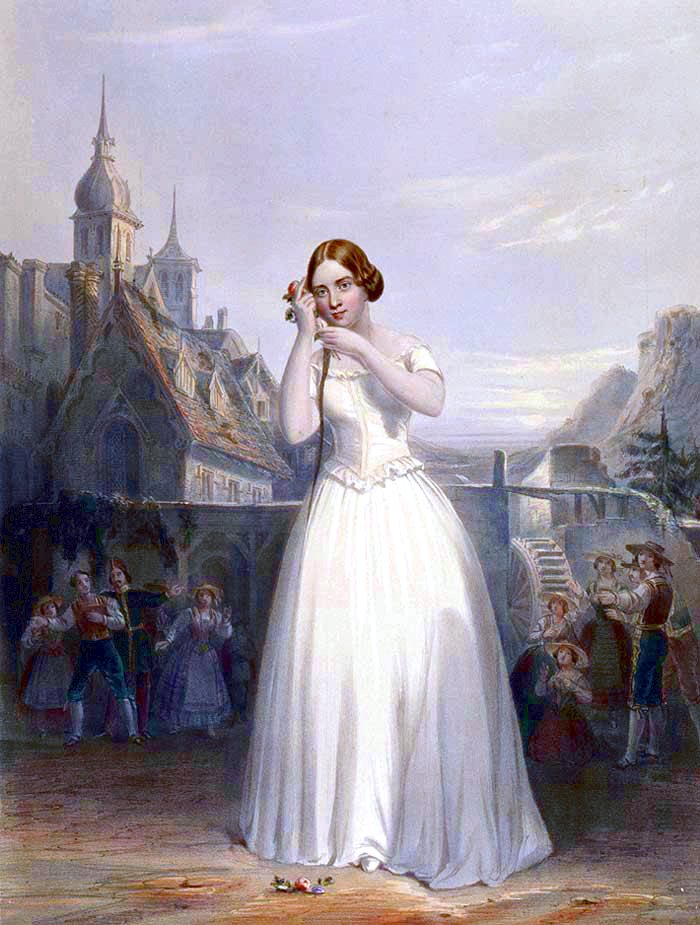
The 19th century singer Jenny Lind depicted performing La sonnambula
"The most significant feature of the emergent popular music industry of
the late 18th and early 19th centuries was the extent of its focus on
the commodity form of sheet music".[27] The availability of
inexpensive, widely available sheet music versions of popular songs and
instrumental music pieces made it possible for music to be disseminated
to a wide audience of amateur, middle-class music-makers, who could
play and sing popular music at home. Amateur music-making in the 19th
century often centred around the piano, as this instrument could play
melodies, chords and basslines, thus enabling a pianist to reproduce
popular songs and pieces. In addition to the influence of sheet music,
another factor was the increasing availability during the late 18th and
early 19th century of public popular music performances in "pleasure
gardens and dance halls, popular theatres and concert rooms".[27]
The early popular music performers worked hand-in-hand with the sheet
music industry to promote popular sheet music. One of the early popular
music performers to attain widespread popularity was a Swedish opera
singer Jenny Lind, who toured the US in the mid-19th century. In
addition to living room amateur music-making during the 19th century,
more people began getting involved in music during this era by
participating in amateur choirs, joining brass bands or playing in
amateur orchestras.[citation needed]
The center of the music publishing industry in the US during the late
19th century was in New York's 'Tin Pan Alley' district. The Tin Pan
Alley music publishers developed a new method for promoting sheet
music: incessant promotion of new songs. One of the technological
innovations that helped to spread popular music around the turn of the
century was player pianos. A player piano could be used to record a
skilled pianist's rendition of a piano piece. This recorded performance
could be "played back" on another player piano. This allowed a larger
number of music lovers to hear the new popular piano tunes.[27] By the
early 1900s, the big trends in popular music were the increasing
popularity of vaudeville theaters and dance halls and a new
invention—the gramophone player. The record industry grew very rapidly;
"By 1920 there were almost 80 record companies in Britain, and almost
200 in the USA".[27] The availability of records enabled a larger
percentage of the population to hear the top singers and
bands.[citation needed]
Radio broadcasting of music, which began in the early 1920s, helped to
spread popular songs to a huge audience, enabling a much larger
proportion of the population to hear songs performed by professional
singers and music ensembles, including individuals from lower income
groups who previously would not have been able to afford concert
tickets. Radio broadcasting increased the ability of songwriters,
singers and bandleaders to become nationally known. Another factor
which helped to disseminate popular music was the introduction of
"talking pictures"—sound films—in the late 1920s, which also included
music and songs. In the late 1920s and throughout the 1930s, there was
a move towards consolidation in the recording industry, which led
several major companies to dominate the record industry.[27]
In the 1950s and 1960s, the new invention of television began to play
an increasingly important role in disseminating new popular music.
Variety shows regularly showcased popular singers and bands. In the
1960s, the development of new technologies in recording, such as
multitrack recorders gave sound engineers and record producers an
increasingly important role in popular music. By using multitrack
recording techniques, sound engineers could create new sounds and sound
effects that were not possible using traditional "live" recording
techniques,[27] such as singers performing their own backup vocals or
having lead guitarists play rhythm guitars behind their guitar solo.
During the 1960s era of psychedelic music, the recording studio was
used to create even more unusual sounds, in order to mimic the effect
of taking hallucinogenic drugs, some songs used tapes of instruments
played backwards or panned the music from one side to the other of the
stereo image.[citation needed] The next decade saw moves away from
these sensibilities, as Robert Christgau noted in Christgau's Record
Guide: Rock Albums of the Seventies (1981):
"In popular music, embracing the '70s meant both an elitist withdrawal
from the messy concert and counterculture scene and a profiteering
pursuit of the lowest common denominator in FM radio and album rock ...
In the '70s the powerful took over, as rock industrialists capitalized
on the national mood to reduce potent music to an often reactionary
species of entertainment—and to transmute rock's popular base from
audience to market."[28]
In the 1970s, the trend towards consolidation in the recording industry
continued to the point that the "... dominance was in the hands of five
huge transnational organizations, three American-owned (WEA, RCA, CBS)
and two European-owned companies (EMI, Polygram)".[according to whom?]
In the 1990s, the consolidation trend took a new turn: inter-media
consolidation. This trend saw music recording companies being
consolidated with film, television, magazines, and other media
companies, an approach which facilitated cross-marketing promotion
between subsidiaries. For example, a record company's singing star
could be cross-promoted by the conglomerate's television talk shows and
magazine arms.[27]
The "introduction of digital equipment (mixing desks, synthesizers,
samplers, sequencers)" in the 1980s resulted in what Grove Dictionary
of Music dubbed the creation of "new sound worlds", as well as
facilitating DIY music production by amateur musicians and "tiny
independent record labels".[27] In the 1990s, the availability of sound
recording software and effects units software meant that an amateur
indie band could record an album—which required a fully equipped
recording studio in previous decades—using little more than a laptop
and a good quality microphone.[citation needed] That said, the audio
quality of modern recording studios still outstrips what an amateur can
produce.[29]
Criticism
Main article: Music journalist
See also: Rockism and poptimism
|
北米とヨーロッパにおける発展
産業
主な記事 音楽産業
以下も参照のこと: アルバム時代
このセクションでは、検証のために追加の引用が必要である。このセクションに信頼できる情報源への引用を追加することで、この記事の改善にご協力いただき
たい。ソースのないものは異議申し立てされ、削除される可能性がある。(2016年8月)(このメッセージを削除する方法とタイミングを学ぶ)

19世紀の歌手ジェニー・リンドがラ・ソンナンブラを演奏する様子を描いた
「18世紀後半から19世紀初頭にかけて勃興したポピュラー音楽産業の最も大きな特徴は、楽譜という商品形態に焦点を当てたことである」[27]。ポピュ
ラー歌曲や器楽曲の楽譜が安価で広く入手できるようになったことで、家庭でポピュラー音楽を演奏したり歌ったりすることができるアマチュアの中産階級の音
楽制作者の幅広い聴衆に音楽を広めることが可能になった。19世紀のアマチュアの音楽制作は、ピアノを中心に行われることが多かった。ピアノという楽器
は、メロディー、コード、ベースラインを演奏することができたため、ピアニストは流行歌や流行曲を再現することができたのである。楽譜の影響に加え、もう
一つの要因は、18世紀後半から19世紀初頭にかけて、「歓楽園やダンスホール、大衆劇場やコンサートホール」での大衆音楽演奏の機会が増えたことであっ
た[27]。
初期のポピュラー音楽演奏家たちは、ポピュラー楽譜の普及のために楽譜産業と手を携えていた。広範な人気を獲得した初期のポピュラー音楽演奏家のひとり
に、19世紀半ばにアメリカをツアーしたスウェーデンのオペラ歌手ジェニー・リンドがいる。19世紀には、リビングルームでのアマチュア音楽制作に加え
て、アマチュア合唱団に参加したり、ブラスバンドに参加したり、アマチュアオーケストラで演奏したりすることで、より多くの人々がこの時代に音楽に関わり
始めた[要出典]。
19世紀後半のアメリカにおける音楽出版産業の中心は、ニューヨークの「ティン・パン・アレイ」地区であった。ティン・パン・アレーの音楽出版社は、楽譜
を広めるための新しい方法、つまり新曲の絶え間ない宣伝を開発した。世紀の変わり目にポピュラー音楽を広めるのに役立った技術革新のひとつが、プレーヤー
ピアノだった。プレーヤー・ピアノを使えば、熟練したピアニストがピアノ曲を演奏する様子を録音することができた。この録音された演奏は、別のプレーヤー
ピアノで「再生」することができた。これにより、より多くの音楽愛好家が新しいポピュラーピアノの曲を聴くことができるようになった[27]。1900年
代初頭までに、ポピュラー音楽の大きなトレンドは、ボードビル劇場やダンスホールの人気の高まりと、蓄音機プレーヤーという新しい発明であった。レコード
産業は急速に成長し、「1920年までにイギリスには80社近く、アメリカには200社近くのレコード会社があった」[27]。
1920年代初頭に始まった音楽のラジオ放送は、ポピュラーソングを多くの聴衆に広めるのに役立ち、以前はコンサートのチケットを買うことができなかった
低所得層の個人も含め、プロの歌手や音楽アンサンブルが演奏する曲を聴くことができるようになった。ラジオ放送は、作詞家、歌手、バンドリーダーの全国的
な知名度を高めた。ポピュラー音楽の普及に貢献したもう一つの要因は、1920年代後半に「トーキング・ピクチャーズ」(音の出る映画)が導入されたこと
である。1920年代後半から1930年代にかけて、レコード業界では統合の動きがあり、いくつかの大手企業がレコード業界を支配するようになった
[27]。
1950年代と1960年代には、テレビという新しい発明が、新しいポピュラー音楽を広める上でますます重要な役割を果たすようになった。バラエティ番組
では定期的に人気歌手やバンドが紹介された。1960年代には、マルチトラックレコーダーなどの新しい録音技術が開発され、サウンドエンジニアやレコード
プロデューサーがポピュラー音楽においてますます重要な役割を果たすようになった。マルチトラック・レコーディングの技術を使うことで、サウンド・エンジ
ニアは、歌手が自分のバック・ボーカルを演奏したり、リード・ギタリストがギター・ソロの後ろでリズム・ギターを演奏したりするなど、従来の「ライブ」レ
コーディング技術では不可能だった新しいサウンドや音響効果を生み出すことができた[27]。1960年代のサイケデリック・ミュージックの時代には、レ
コーディング・スタジオはさらに珍しいサウンドを作り出すために使われ、幻覚作用のあるドラッグを服用したときの効果を模倣するために、楽器を逆再生した
テープを使ったり、ステレオ画像の片側からもう片側へ音楽をパンニングしたりする曲もあった[要出典]。次の10年間は、ロバート・クリストガウが『クリ
ストガウのレコード・ガイド』で述べているように、こうした感覚から離れる動きが見られた: 1981年)の中でロバート・クリストガウが述べている:
ポピュラー音楽において、70年代を受け入れることは、雑然としたコンサートやカウンターカルチャー・シーンからのエリート主義者の撤退と、FMラジオや
アルバム・ロックにおける最小公倍数の利益追求の両方を意味した...」。70年代には権力者が支配し、ロック産業家たちが国民的なムードに乗じて、強力
な音楽をしばしば反動的なエンターテインメントの一種に貶め、ロックの大衆基盤を聴衆から市場へと変質させた」[28]。
1970年代、レコード産業における統合の傾向は続き、「......支配は、アメリカ所有の3社(WEA、RCA、CBS)とヨーロッパ所有の2社
(EMI、ポリグラム)の、5つの巨大な多国籍組織の手中にあった」[誰によれば?]。1990年代、統合の傾向はメディア間の統合という新たな展開を見
せた。この傾向では、音楽レコード会社が映画、テレビ、雑誌、その他のメディア企業と統合され、子会社間のクロス・マーケティング・プロモーションを促進
するアプローチとなった。例えば、あるレコード会社の歌手スターは、コングロマリットのテレビのトークショーや雑誌部門とクロスプロモーションを行うこと
ができた[27]。
1980年代の「デジタル機器(ミキシング・デスク、シンセサイザー、サンプラー、シーケンサー)の導入」は、グローブ音楽辞典が「新しい音の世界」の創
造と称する結果をもたらし、アマチュア・ミュージシャンや「小さな独立系レコード会社」によるDIY音楽制作を促進した。
[1990年代には、サウンドレコーディングソフトウェアやエフェクターソフトウェアが利用できるようになったため、アマチュアのインディーズバンドで
あっても、ラップトップと良質なマイクを使うだけで、それまでの数十年間は設備の整ったレコーディングスタジオが必要だったアルバムをレコーディングでき
るようになった[要出典]。
批判
主な記事 音楽ジャーナリスト
以下も参照のこと: ロック主義とポップティミズム
|
Popular genres of music
This section needs additional citations for verification. Please help
improve this article by adding citations to reliable sources in this
section. Unsourced material may be challenged and removed. (April 2024)
(Learn how and when to remove this message)
There are many genres of music worldwide, over 300. Leading for the
most popular genres worldwide, pop music takes the first spot. In
countries like the US, include hip-hop, blues, RNB, and rap take the
leading spots.
The most popular genres of music rank differently throughout the world.
However, there are also very niche genres of music. For example, in
Canada the most popular niche genre of music is video game soundtracks.
In Sweden, black metal is a niche genre of music. In South India,
Carnatic is a niche genre of music people enjoy listening to.
Music genre popularity changes greatly over time. This can be
influenced by a number of factors such as current trends or even
historical events. In America during the 1980s, rock music was at its
peak and then slowly lost its top spot as pop music began to climb the
charts. Since the early 2000s, pop music has charted number one in
American music charts, but since 2017, RnB and Hip Hop have taken that
spot.
|
音楽の人気ジャンル
このセクションでは、検証のために追加の引用が必要である。このセクションに信頼できる情報源への引用を追加することで、この記事の改善にご協力いただき
たい。ソースのないものは異議申し立てがなされ、削除される可能性がある。(2024年4月)(このメッセージを削除する方法とタイミングを学ぶ)
世界には数多くの音楽ジャンルがあり、その数は300を超える。世界で最も人気のあるジャンルは、ポップミュージックが1位である。アメリカなどでは、ヒップホップ、ブルース、RNB、ラップなどが上位を占めている。
音楽の人気ジャンルは、世界中で順位が異なる。しかし、非常にニッチなジャンルの音楽もある。例えば、カナダで最も人気のあるニッチな音楽ジャンルはビデ
オゲームのサウンドトラックだ。スウェーデンではブラックメタルがニッチな音楽ジャンルだ。南インドでは、カーナティックがニッチなジャンルの音楽として
親しまれている。
音楽ジャンルの人気は時間とともに大きく変化する。これは、現在のトレンドや歴史的な出来事など、さまざまな要因に影響される。1980年代のアメリカで
は、ロック・ミュージックが最盛期を迎え、その後ポップ・ミュージックがチャートを席巻し始めたため、徐々にトップの座を失っていった。2000年代初頭
以降、アメリカの音楽チャートではポップ・ミュージックが1位を獲得してきたが、2017年以降はRnBとヒップホップがその座を奪っている。
|
Changes
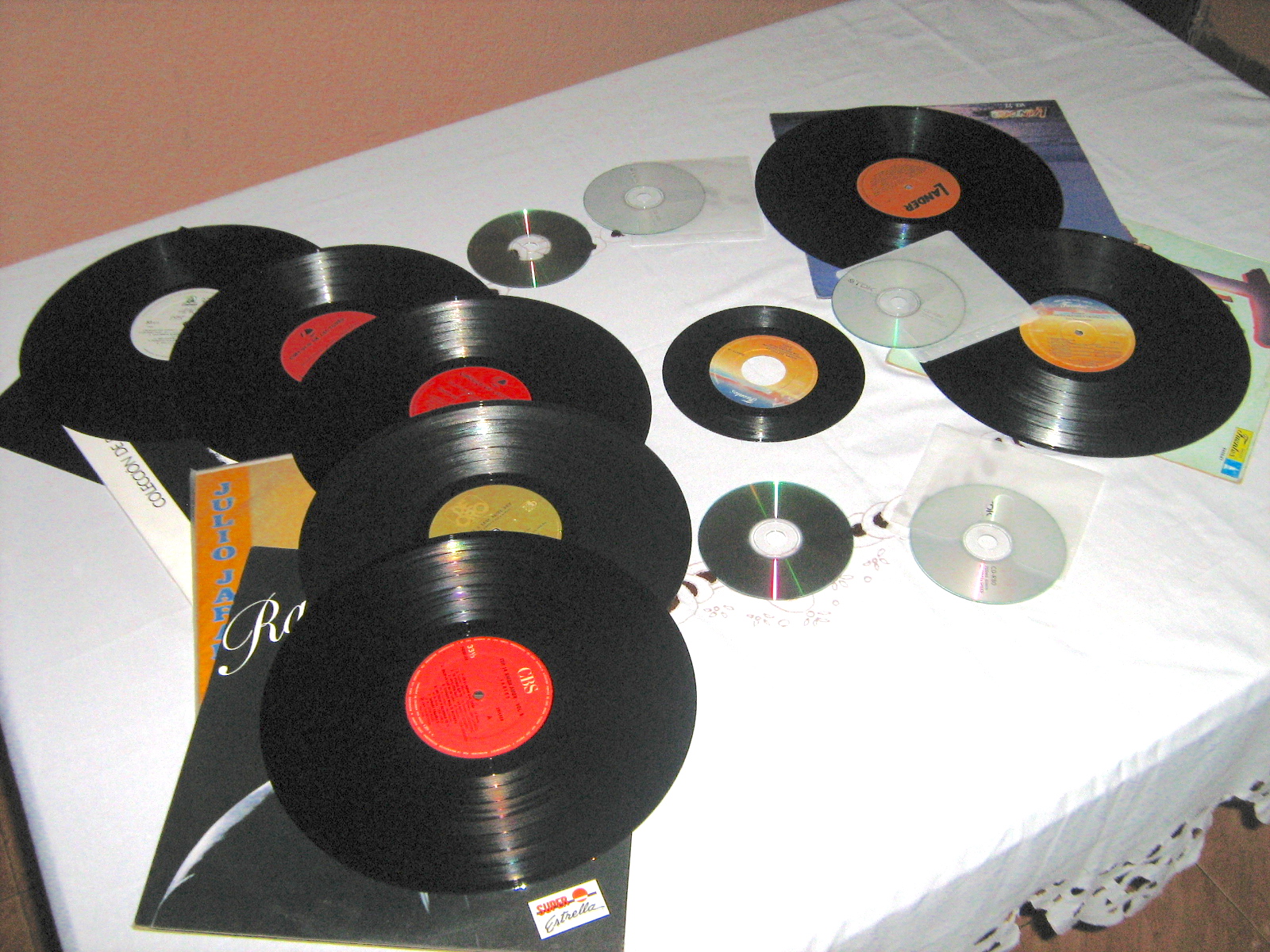
Since the 20th century, several music formats received dominance, from 7-inch vinyl, to 12-inch vinyl, to CDs.
In addition to many changes in specific sounds and technologies used,
there has been a shift in the content and key elements of popular music
since the 1960s. One major change is that popular music has gotten
slower; the average BPM of popular songs from the 1960s was 116, while
the average of the 2000s was 100BPM.[30] Additionally, songs getting
radio play in the 1960s were, on average, only about three minutes
long.[31] In contrast, most of the songs in the Billboard Top 5 in 2018
were between 3:21 and 3:40 minutes long.[32] There has also been a drop
in the use of major keys and a rise in the use of minor keys since the
1960s; 85% of songs were in a major key in that decade, while only
around 40% of songs are in a major key now.[33] The subject matter and
lyrics of popular music have also undergone major change, becoming
sadder[34][35] as well as more antisocial and self-centered since the
1960s.[33] There has also been an increasing trend of songs' emotional
content, key, and tempo not following common associations; for example,
fast songs with sad subject matters or in a minor key, or slow songs
with happier content or in a major key.[33]
There are multiple possible explanations for many of these changes. One
reason for the brevity of songs in the past was the physical capability
of records. Vinyl record singles, which were heavily favored for radio
play, only had room for about three minutes of music, physically
limiting the possible length of popular songs.[31] With the invention
of CDs in 1982, and more recently with streaming, music can be as long
or short as both writers and listeners wish. However, songs have
shortened again, partially due to the ubiquity of streaming. The
average song length in 2018 was 3 minutes and 30 seconds, 20 seconds
shorter than the average in 2014.[36] The most probable cause of this
is that artists are now paid per individual stream, and longer songs
could mean fewer streams. As for the difference in songs' subject
matter and emotional content, popular music since the late 1960s has
increasingly been used to promote social change and political agendas.
Artists since that time have often focused their music on current
events and subjects relevant to the current generations. Another theory
is that globalization makes audiences' tastes more diverse, so
different ideas in music have a chance to gain popularity.[33]
|
変遷

20世紀以降、7インチ・レコード、12インチ・レコード、CDと、いくつかの音楽フォーマットが主流を占めてきた。
具体的なサウンドや使用される技術に多くの変化があったことに加え、1960年代以降、ポピュラー音楽の内容や主要要素にも変化があった。1960年代の
ポピュラー音楽の平均BPMは116であったのに対し、2000年代の平均は100BPMである。
[31]対照的に、2018年のビルボードトップ5にランクインした曲のほとんどは、3分21秒から3分40秒の長さであった[32]。
[ポピュラー音楽の主題や歌詞もまた大きな変化を遂げており、1960年代以降、より悲しく[34][35]、反社会的で自己中心的なものになっている
[33]。
このような変化の多くには、複数の説明が考えられる。かつての曲が短かった理由のひとつは、レコードの物理的な性能にあった。1982年にCDが発明さ
れ、最近ではストリーミングによって、音楽は作家とリスナーの両方が望むだけ長くも短くもできるようになった[31]。しかし、ストリーミングの普及も
あって、楽曲は再び短くなっている。2018年の平均曲の長さは3分30秒で、2014年の平均より20秒短くなっている[36]。この最も可能性の高い
原因は、アーティストが個々のストリーミングごとに報酬を得るようになったことであり、曲が長いとストリーミング数が減る可能性がある。曲の主題や感情的
な内容の違いに関しては、1960年代後半以降のポピュラー音楽は、社会変革や政治的な意図を促進するために使われることが多くなった。1960年代後半
以降のアーティストたちは、時事問題や現在の世代に関連するテーマに音楽を集中させることが多くなった。もう一つの説は、グローバル化によって聴衆の嗜好
が多様化し、音楽における異なる考え方が人気を得る機会が増えたというものだ[33]。
|
Global perspective
In contrast to Western popular music, a genre of music that is popular
outside of a Western nation, is categorized into World music. This
label turns otherwise popular styles of music into an exotic and
unknown category. The Western concept of 'World Music' homogenizes many
different genres of popular music under one accessible term for Western
audiences.[21] New media technology has led urban music styles to
filter into distant rural areas across the globe. The rural areas, in
turn, are able to give feedback to the urban centers about the new
styles of music.[16] Urbanization, modernization, exposure to foreign
music and mass media have contributed to hybrid urban pop styles. The
hybrid styles have also found a space within Western popular music
through the expressions of their national culture.[15] Recipient
cultures borrow elements from host cultures and alter the meaning and
context found in the host culture. Many Western styles, in turn, have
become international styles through multinational recording studios.[15]
Africa
See also: African popular music
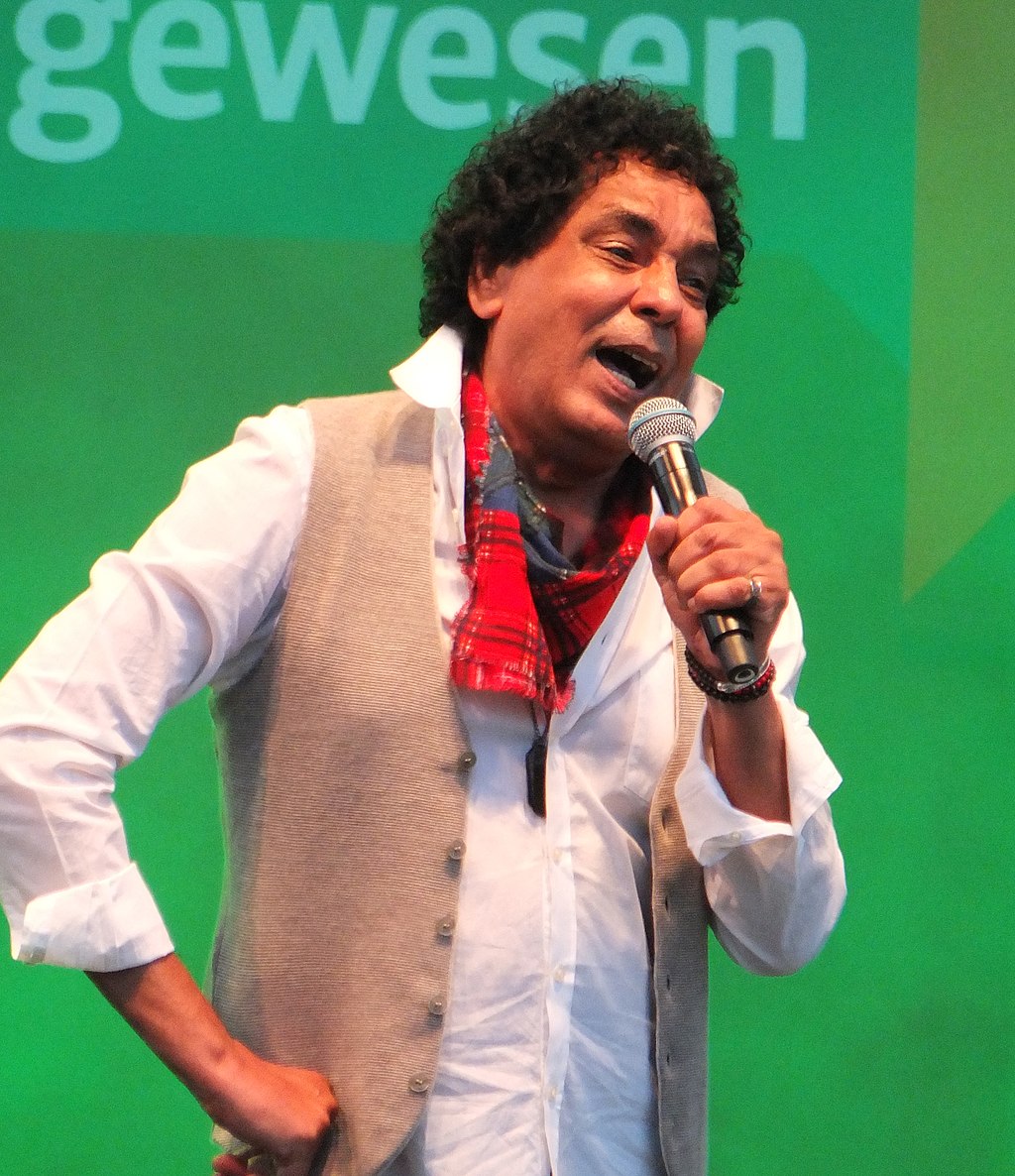
Mohamed_Mounir,_b
Egyptian pop star Mohamed Mounir
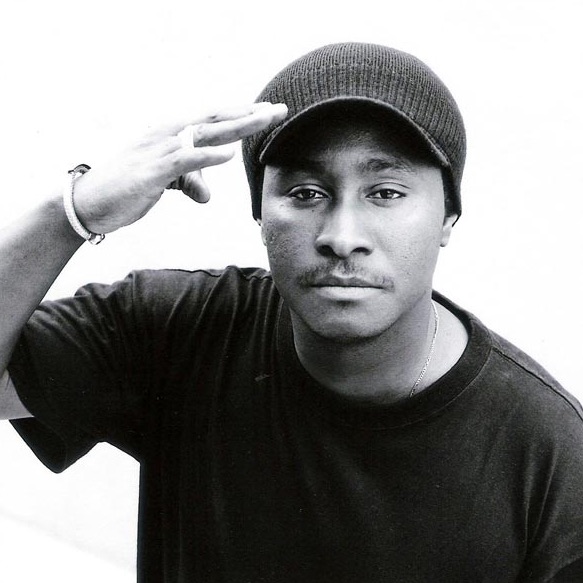
Senegalese rapper Didier Awadi
Popular African music styles have stemmed from traditional
entertainment genres, rather than evolving from music used with certain
traditional ceremonies like weddings, births, or funerals.[15] African
popular music as a whole has been influenced by European countries,
African-American and Afro-Latin music, and region-specific styles that
became popular across a wider range of people. Although due to the
significance and strong position of culture in traditional African
music, African popular music tends to stay within the roots of
traditional African Popular Music.[37][15] The genre of music,
Maskanda, is popular in its culture of origin, South Africa. Although
maskanda is a traditional music genre by definition, the people who
listen to it influence the ideals that are brought forth in the
music.[38] A popular maskandi artist, Phuzekhemisi, had to lessen the
political influence within his music to be ready for the public sphere.
His music producer, West Nkosi, was looking for the commercial success
in Phuzekhemisi's music rather than starting a political
controversy.[38]
Political songs have been an important category of African popular
music in many societies. During the continent's struggle against
colonial rule, nationalistic songs boosted citizens' morale. These
songs were based on Western marches and hymns reflecting the European
education system that the early nationalistic leaders grew up in. Not
all African political songs were based on Western styles. For example,
in South Africa, the political songs during the Anti-Apartheid Movement
were based on traditional tribal styles along with hybrid forms of
imported genres.[15] Activists used protest and freedom songs to
persuade individuals to take action, become educated with the struggle,
and empower others to be politically conscious.[39] These songs
reflected the nuances between the different classes involved in the
liberation struggle.[15]
One of the genres people of Africa use for political expression is Hip
hop.[40] Although hip hop in Africa is based on the North American
template, it has been remade to produce new meanings for African young
people. This allows the genre to be both locally and globally
influential.[40] African youth are shaped by the fast-growing genre's
ability to communicate, educate, empower, and entertain.[40] Artists
who would have started in traditional music genres, like maskanda,
became hip hop artists to provide a stronger career path for
themselves. These rappers compare themselves to the traditional artists
like the griot and oral storyteller, who both had a role in reflecting
on the internal dynamics of the larger society.[40] African hip hop
creates youth culture, community intelligence, and global
solidarity.[40]
America
United States
In the contemporary United States, one of the most popular forms of
music is rap.[41] DJ Kool Herc, is famously known for creating hip-hop
itself in the 1970s.[42] With the technique he created when mixing two
identical records back and forth, he was able to make unique-sounding
sounds that later gave birth to rap itself. In modern times, rap is
used to bring awareness to a problem such as: racism, sexism, and much
more.[43] It developed communities in a culture regarding music.
Asia
Indonesia
Further information: Music of Indonesia
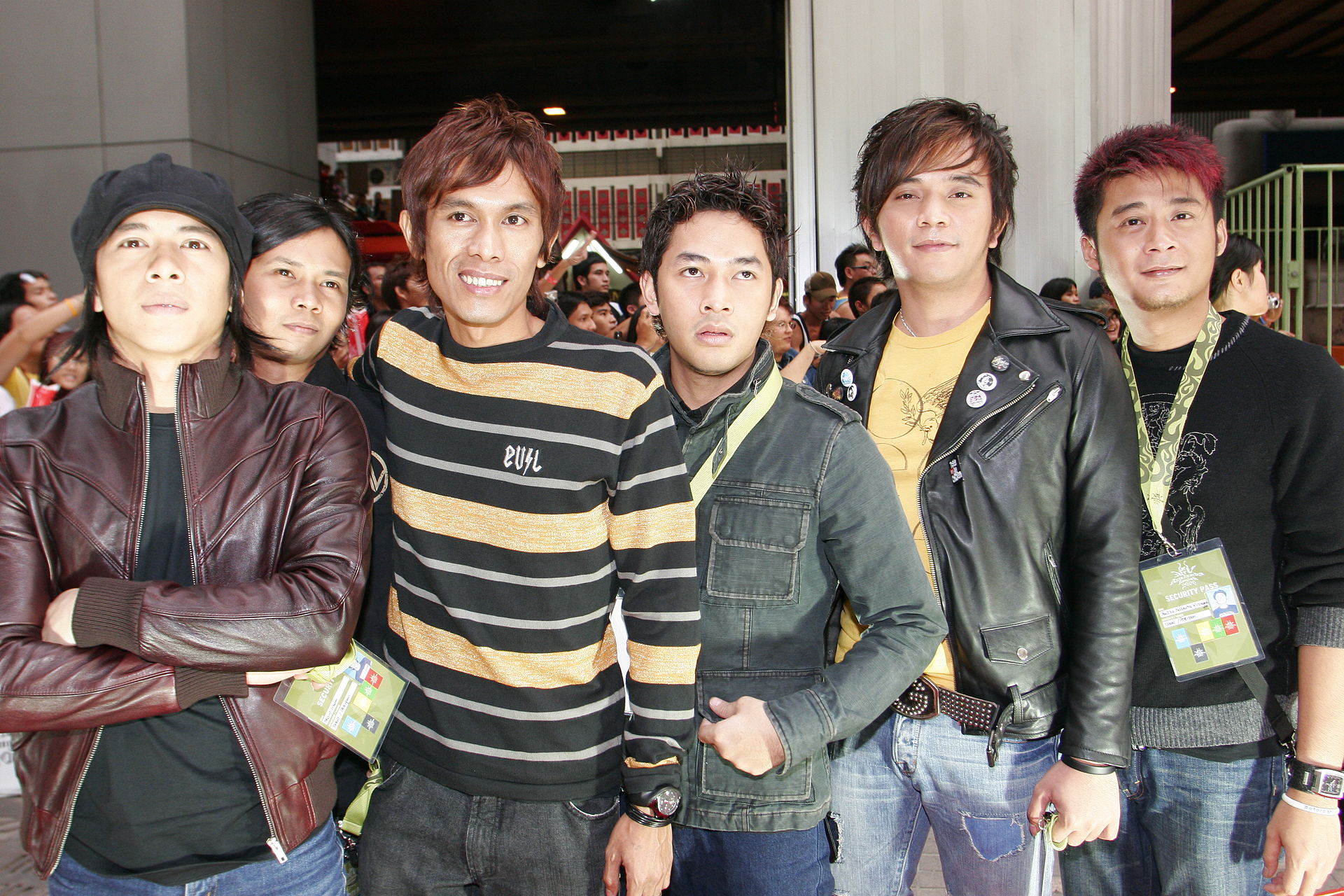
Noah, one of Indonesia's popular bands
Popular music in Indonesia is often categorized as hybrid forms of
Western rock to genres that originated in Indonesia and are indigenous
in style.[15] The genre of music Dangdut is a genre of popular music
specifically found in Indonesia. Dangdut formed from two other genres
of popular music: indo pop and underground music[44] coming together to
create a new fusion genre. Dangdut takes the noisy instrumentation from
underground music, but makes it easier to listen to, like indo pop.
Dangdut attempts to form many popular music genres like rock, pop, and
traditional music to create a new sound that lines up with the
consumers' tastes.[45] This genre has formed into a larger social
movement that includes clothing, youth culture, the resurgence of
Islam, and the capitalist entertainment industry.[15]
Another music scene that is popular in Indonesia is punk rock. This
genre was shaped in Indonesia by the local interpretations of the media
from the larger global punk movement.[44] Jeremy Wallach argues that
while Green Day was seen as the "death of punk," in Indonesia they were
seen catalyst for a larger punk movement.[44] Punk in Indonesia calls
on the English-speaking world to embrace the global sects of the punk
subculture and become open-minded to the transnational genre.[44]
China
In a 2015 study involving young students in Shanghai, youths stated
they enjoyed listening to both Chinese, other Asian nationalities, and
Anglo-American popular music. There are three ways that young people of
China were able to access global music.[22] The first reason was a
policy change since the late 1970s where the country was opened up to
the rest of the world instead of being self-contained. This created
more opportunities for Chinese people to interact with people outside
of their country of origin to create a more globalized culture. The
second reason is that the Chinese television and music industry since
the 1980s has broadcast television shows from their neighboring Asian
societies and the West. The third reason is the impact of the internet
and smartphones on the accessibility of streaming music.[22]
In 2015, students in China accounted for 30.2% of China's internet
population and the third and fifth most popular uses of the internet
were respectively, internet music and internet video use. The youths
described being able to connect to the emotions and language of the
Chinese music, but also enjoyed the melodies found within
Anglo-American music. The students also believed that listening to the
English music would improve their English language skills.[22]
Middle East
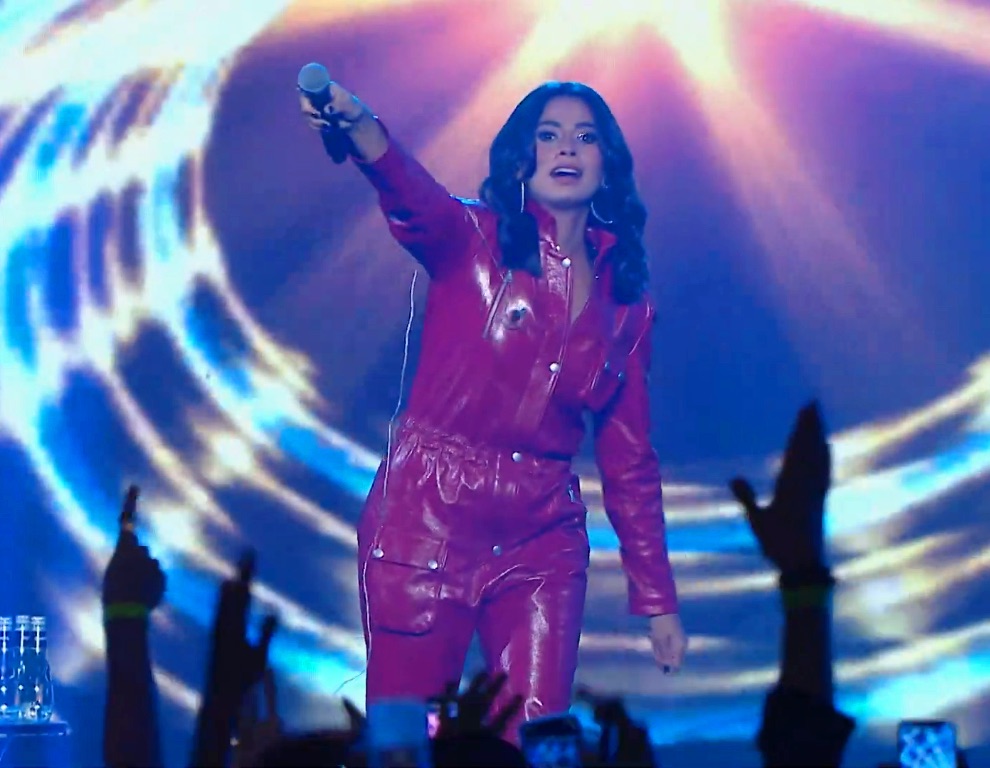
Ruby_(Egyptian_Singer)_6
Ruby, Egyptian singer performing
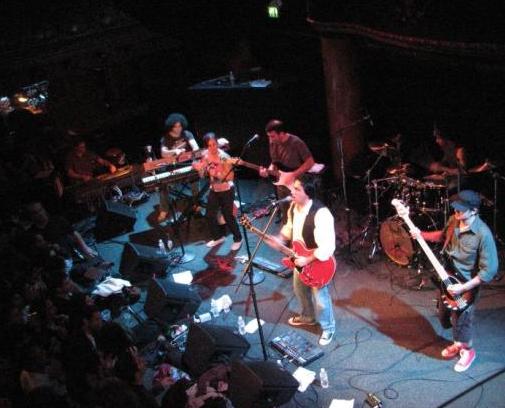
Iranian rock band Kiosk, live in 2007
Modernization of music in the Arab world involved borrowing inspiration
from Turkish music and Western musical styles.[46] The late Egyptian
singer, Umm Kulthum, stated,
"We must respect ourselves and our art. The Indians have set a good
example for us - they show great respect for themselves and their arts.
Wherever they are, they wear their native dress and their music is
known throughout the world. This is the right way."
She discussed this to explain why Egypt and the Arab world needed to
take pride in the popular music styles originating in their culture so
the styles were not lost in the modernization.[46] Local musicians
learned Western instrumental styles to create their own popular styles
including their native languages and indigenous musical features.[46]
Communities in throughout the Arab world place high value on their
indigenous musical identities while assimilating to new musical styles
from neighboring countries or mass media.[46] Through the 1980s and
1990s, popular music has been seen as a problem for the Iranian
government because of the non-religious meanings within the music and
the bodily movements of dancing or headbanging.[47] During this time
period, metal became a popular underground subculture through the
Middle East. Just like their Western counterparts, Middle Eastern metal
followers expressed their feelings of alienation. But their thoughts
came from war and social restrictions on youth.[48]
In interviews of Iranian teenagers between 1990 and 2004, the youth
overall preferred Western popular music, even though it was banned by
the government.[47] Iranian underground rock bands are composed of
members who are young, urban-minded, educated, relatively well-off, and
global beings. Iranian rock is described by the traits that these band
members possess.[47] The youth who take part in underground music in
the Middle East are aware of the social constraints of their countries,
but they are not optimistic about social change.[48] Iranian rock bands
have taken up an internationalist position to express their rebellion
from the discourses in their national governments.[47]
|
グローバルな視点
西洋のポピュラー音楽とは対照的に、西洋以外の国で人気のある音楽のジャンルは、ワールド・ミュージックに分類される。このレッテルは、それ以外のポピュ
ラー音楽のスタイルを、エキゾチックで未知のカテゴリーに変えてしまう。西洋の「ワールド・ミュージック」という概念は、西洋の聴衆にとって利用しやすい
1つの用語の下に、多くの異なるジャンルのポピュラー音楽を均質化するものである[21]。新しいメディア技術によって、都市部の音楽スタイルが、世界中
の遠く離れた地方にまで浸透するようになった。都市化、近代化、外国の音楽やマスメディアへの接触が、ハイブリッドなアーバン・ポップ・スタイルを生み出
した。ハイブリッド・スタイルはまた、自国の文化を表現することによって、西洋のポピュラー音楽の中に居場所を見出している[15]。多くの西洋のスタイ
ルは、多国籍のレコーディング・スタジオを通じて国際的なスタイルとなった[15]。
アフリカ
以下も参照のこと: アフリカのポピュラー音楽

モハメド・ムニール
エジプトのポップスター、モハメド・ムニール

セネガルのラッパー、ディディエ・アワディ
アフリカのポピュラー音楽のスタイルは、結婚式、出産、葬式などの特定の伝統的な儀式で使われる音楽から発展したというよりは、伝統的な娯楽ジャンルから
生まれたものである[15]。アフリカのポピュラー音楽は全体として、ヨーロッパ諸国、アフリカ系アメリカ人、アフロ・ラテン系音楽、地域特有のスタイル
から影響を受け、より幅広い人々に広まった。伝統的なアフリカ音楽における文化の重要性と強い位置づけのため、アフリカのポピュラー音楽は伝統的なアフリ
カのポピュラー音楽のルーツにとどまる傾向があるが[37][15]、音楽のジャンルであるマスカンダは、その発祥の文化である南アフリカで人気がある。
マスカンダは定義上伝統的な音楽ジャンルであるが、それを聴く人々は音楽に込められた理想に影響を与える[38]。人気のあるマスカンダ・アーティストで
あるプゼケミシは、公の場に出る準備を整えるために、音楽内の政治的な影響を抑えなければならなかった。彼の音楽プロデューサーであるウェスト・ンコシ
は、政治的論争を起こすよりも、プゼケミシの音楽の商業的成功を求めていた[38]。
政治的な歌は、多くの社会でアフリカのポピュラー音楽の重要なカテゴリーであった。植民地支配に対するアフリカ大陸の闘争時代には、民族主義的な歌が市民
の士気を高めた。これらの歌は、初期の民族主義的指導者たちが育ったヨーロッパの教育システムを反映して、西洋の行進曲や賛美歌に基づいていた。アフリカ
の政治的な歌のすべてが西洋のスタイルに基づいていたわけではない。例えば南アフリカでは、反アパルトヘイト運動中の政治的な歌は、伝統的な部族のスタイ
ルに加え、輸入されたジャンルのハイブリッドな形式に基づいていた[15]。活動家たちは、行動を起こすよう個人を説得し、闘争の教育を受け、政治的な意
識を持つよう他の人々に力を与えるために、抗議と自由の歌を使用した[39]。
アフリカの人々が政治的表現に使うジャンルのひとつにヒップホップがある[40]。アフリカのヒップホップは北米のテンプレートをベースにしているが、ア
フリカの若者にとって新しい意味を生み出すようにリメイクされている。アフリカの若者たちは、急成長しているこのジャンルのコミュニケーション能力、教育
能力、エンパワーメント能力、そしてエンターテイメント能力によって形作られている[40]。マスカンダのような伝統的な音楽ジャンルからスタートしたは
ずのアーティストたちは、自分たちのキャリアをより強固なものにするためにヒップホップ・アーティストになった。これらのラッパーたちは自分たちをグリオ
や口承語り部のような伝統的なアーティストと比較しており、彼らはどちらもより大きな社会の内部力学を反映する役割を持っていた[40]。
アメリカ
アメリカ
現代のアメリカでは、最も人気のある音楽形態のひとつがラップである[41]。DJのクール・ハークは、1970年代にヒップホップそのものを生み出した
ことで有名である[42]。現代では、ラップは人種差別や性差別など、様々な問題に意識を向けるために使われている[43]。
アジア
インドネシア
さらなる情報 インドネシアの音楽

インドネシアの人気バンド、ノア
インドネシアのポピュラー音楽は、西洋のロックとインドネシア発祥の土着的なジャンルのハイブリッド型に分類されることが多い[15]。ダングットはイン
ド・ポップとアンダーグラウンド・ミュージック[44]という他の2つのポピュラー音楽のジャンルから形成され、新しいフュージョン・ジャンルを生み出し
た。Dangdutはアンダーグラウンド・ミュージックからノイジーな楽器を取り入れ、インド・ポップのように聴きやすくしている。Dangdutは、
ロック、ポップス、伝統音楽といった多くのポピュラー音楽のジャンルを形成し、消費者の嗜好に沿った新しいサウンドを作り出そうとしている[45]。この
ジャンルは、衣服、若者文化、イスラム教の復活、資本主義的娯楽産業などを含む、より大きな社会運動へと形成されている[15]。
インドネシアで人気のあるもうひとつの音楽シーンは、パンク・ロックである。ジェレミー・ウォラックは、グリーン・デイが「パンクの死」とみなされた一方で、インドネシアでは彼らがより大きなパンク・ムーブメントの触媒とみなされたと論じている[44]。
中国
上海の若い学生を対象とした2015年の調査では、若者たちは中国、他のアジアの国籍、英米のポピュラー音楽の両方を楽しんで聴いていると述べている。中
国の若者たちがグローバルな音楽にアクセスできるようになったのには、3つの理由がある[22]。1つ目の理由は、1970年代後半からの政策変更で、国
が自己完結していた代わりに世界に開放されたことだ。これにより、中国人が自国以外の人々と交流する機会が増え、よりグローバル化した文化が生まれた。第
二の理由は、1980年代以降、中国のテレビや音楽業界が近隣のアジア社会や欧米のテレビ番組を放送するようになったことである。3つ目の理由は、イン
ターネットとスマートフォンがストリーミング音楽へのアクセシビリティに与えた影響である[22]。
2015年、中国の学生は中国のインターネット人口の30.2%を占め、インターネットの最も人気のある使い方はそれぞれ3番目と5番目で、インターネッ
ト音楽とインターネット動画の利用だった。若者たちは、中国音楽の感情や言語とつながることができると説明したが、英米音楽に見られるメロディーも楽しん
でいた。生徒たちはまた、英語の音楽を聴くことで英語力が向上すると考えていた[22]。
中東

ルビー(エジプト人歌手)_6
エジプト人歌手Rubyのパフォーマンス

イランのロックバンド、キオスクのライブ(2007年
アラブ世界における音楽の近代化には、トルコ音楽や西洋の音楽スタイルからインスピレーションを得ることが必要だった[46]、
「私たちは自分自身と自分たちの芸術を尊重しなければならない。彼らは自分自身と自分たちの芸術をとても尊重している。彼らはどこにいても民族衣装を身にまとい、彼らの音楽は世界中に知れ渡っている。これが正しいやり方なのです」。
彼女は、なぜエジプトやアラブ世界が、自分たちの文化に由来するポピュラー音楽のスタイルを誇りに思う必要があるのか、近代化の中でそのスタイルが失われ
ないようにするため、このように論じた[46]。地元の音楽家たちは、西洋の楽器スタイルを学び、自分たちの母語や固有の音楽的特徴を含む独自のポピュ
ラースタイルを作り出した。
[1980年代から1990年代にかけて、ポピュラー音楽はイラン政府にとって問題視されるようになったが、それは音楽の中にある非宗教的な意味合いや、
ダンスやヘッドバンギングといった身体的な動きが原因であった[47]。中東のメタル・フォロワーたちは、西欧のフォロワーたちと同じように、疎外感を表
現していた。しかし彼らの思いは、戦争や若者に対する社会的制約から来るものだった[48]。
1990年から2004年にかけてのイランのティーンエイジャーへのインタビューでは、若者たちは全体的に、たとえそれが政府によって禁止されていたとし
ても、西洋のポピュラー音楽を好んでいた[47]。イランのアンダーグラウンド・ロック・バンドは、若く、都会志向で、教育を受け、比較的裕福で、グロー
バルな存在であるメンバーで構成されている。イランのロックは、こうしたバンド・メンバーが持つ特徴によって説明される[47]。中東のアンダーグラウン
ド・ミュージックに参加する若者たちは、自国の社会的制約を認識しているが、社会の変化について楽観的ではない[48]。イランのロック・バンドは、各国
政府の言説に対する反発を表明するために、国際主義的な立場をとっている[47]。
|
|
|
|
|
|
|



 ☆
☆